



Biodiv Sci ›› 2012, Vol. 20 ›› Issue (2): 119-137. DOI: 10.3724/SP.J.1003.2012.19175 cstr: 32101.14.SP.J.1003.2012.19175
• Reviews • Previous Articles Next Articles
Yong Wang1,2,*( ), Zhengwang Zhang1, Guangmei Zheng1, Jianqiang Li1,2, Jiliang Xu3, Zhijun Ma4, Atilio Luis Biancucci2
), Zhengwang Zhang1, Guangmei Zheng1, Jianqiang Li1,2, Jiliang Xu3, Zhijun Ma4, Atilio Luis Biancucci2
Received:2011-10-01
Accepted:2012-02-17
Online:2012-03-20
Published:2012-04-09
Contact:
Yong Wang
Yong Wang, Zhengwang Zhang, Guangmei Zheng, Jianqiang Li, Jiliang Xu, Zhijun Ma, Atilio Luis Biancucci. Ornithological research: past twenty years and future perspectives in China[J]. Biodiv Sci, 2012, 20(2): 119-137.
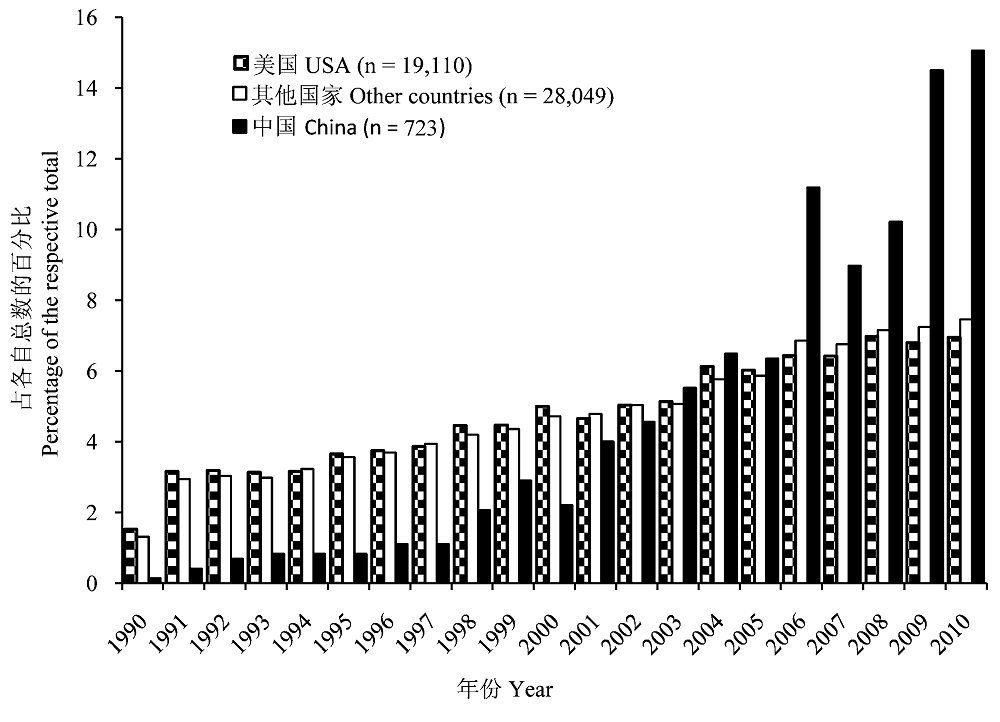
Fig. 1 Respective percentage distribution of avian related journal articles from China (n = 723), USA (n = 19,110) and other countries (n = 28,049) published between 1991 and 2010. Data from Web of Science (Thomson Reuters, 2011).
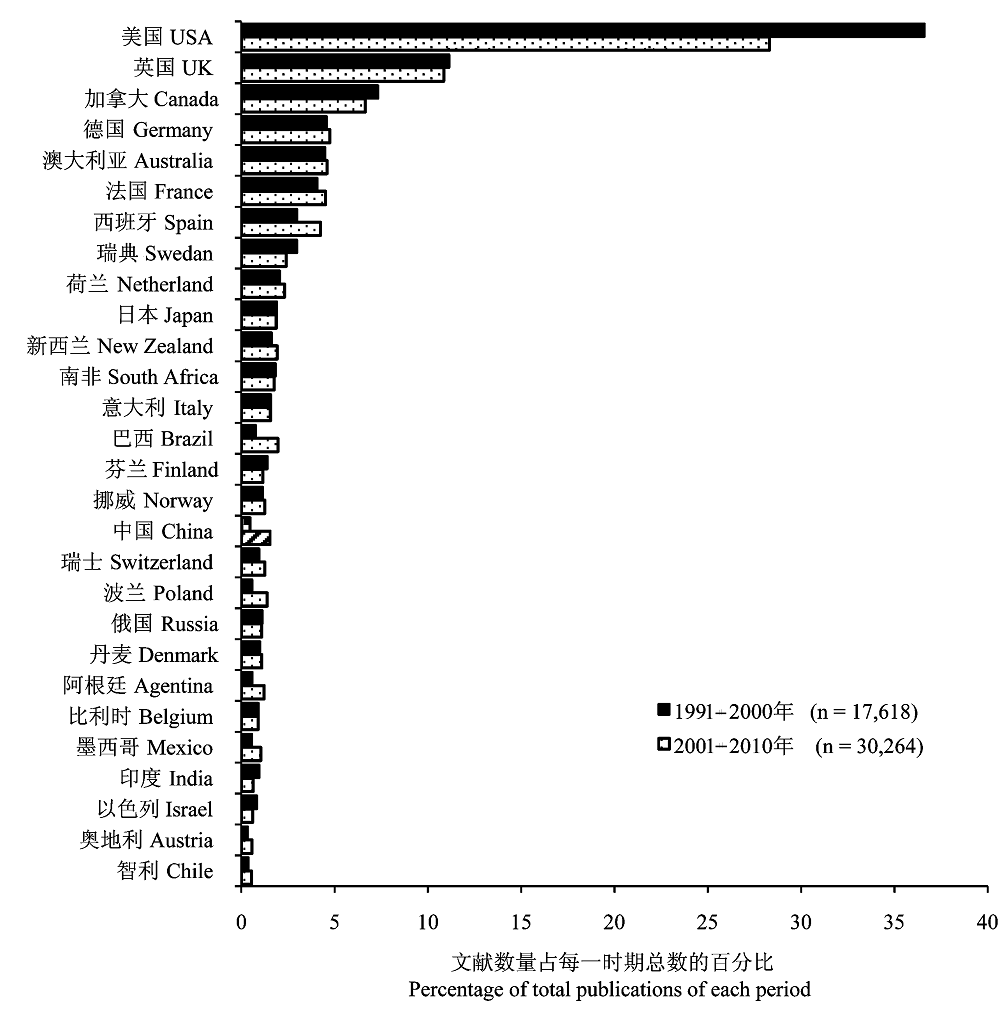
Fig. 2 Percentage distribution by country of published avian articles in relative to the total of each time period: 1991-2000 (17,618) and 2001- 2010(30,264). Data from Web of Science (Thomson Reuters, 2011).
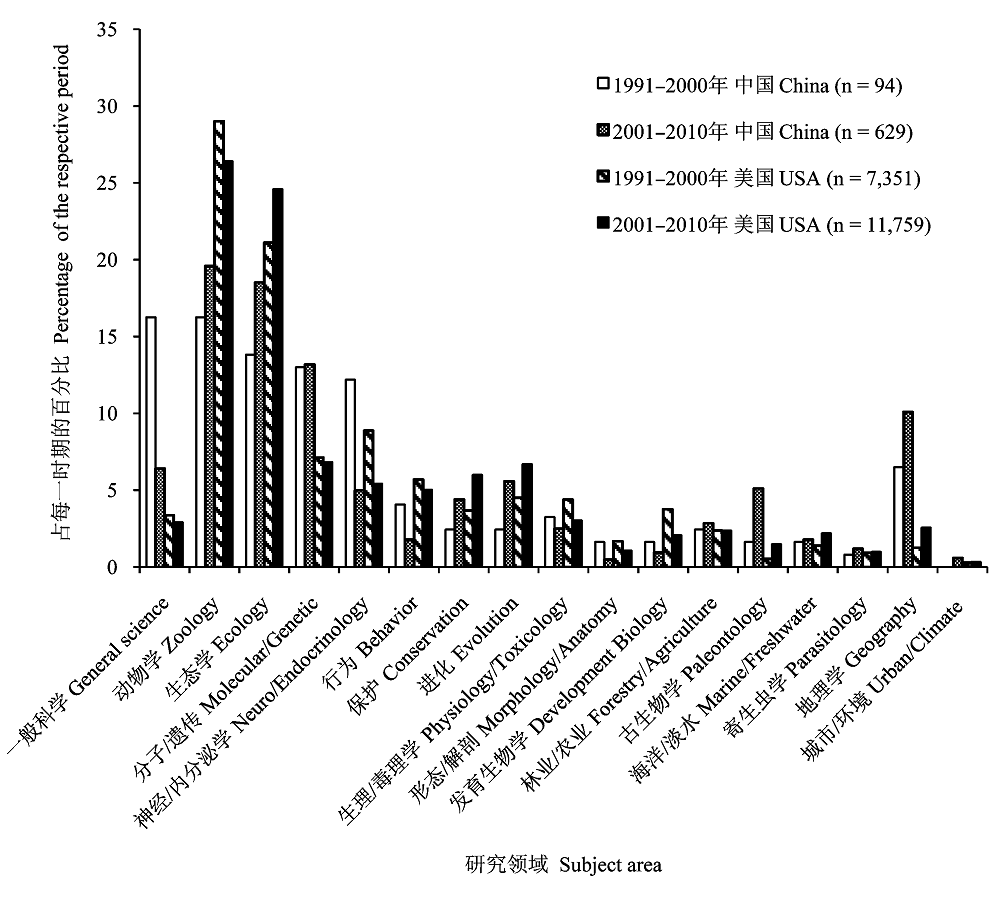
Fig. 3 Disciplinary distribution (per- centage) of avian journal articles from USA and China published during 1991-2000 (7,351 and 94, respectively) and during 2001-2010 (11,759 and 629, respectively). Data from Web of Science (Thomson Reuters, 2011).
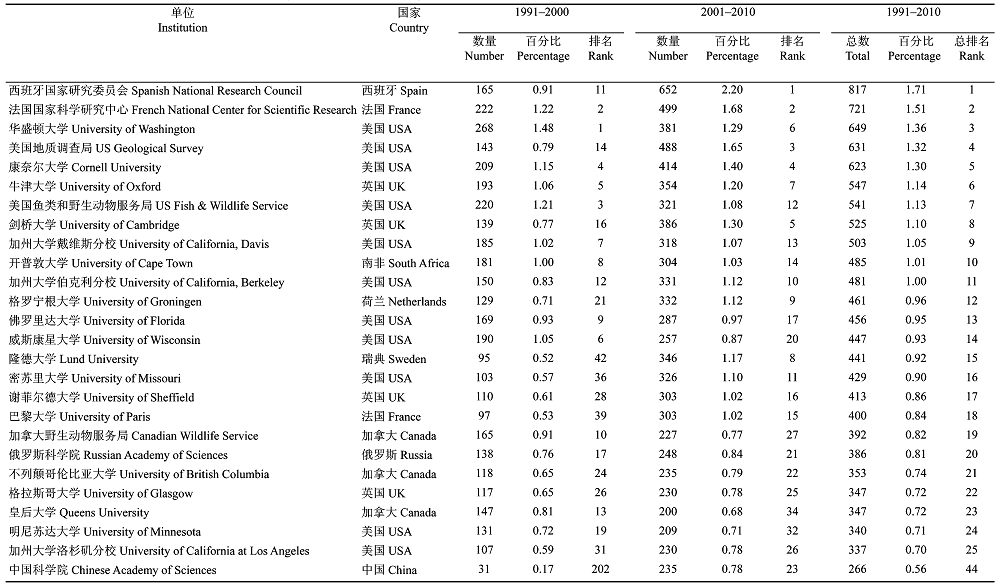 |
Table 1 Major institutions for publishing bird related manuscripts from1991 to 2010. Percentage was calculated based on the total of each period. Total for 1991-2000: 17,617; total for 2001- -2010: 30,265. Data from Web of Science (Thomson Reuters, 2011).
 |
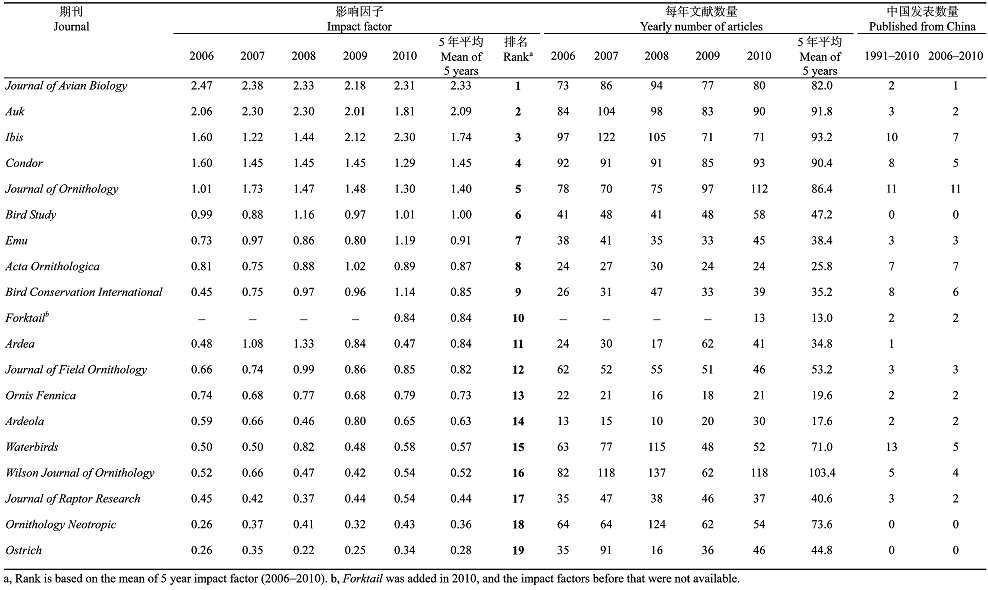 |
Table 2 Major international ormithological journals, yearly publications, and impact factor from 2006-2010 (Data from Web of Knowledge, Journal Citation Report, 2011).
 |
| 单位 Institution | 时段1991-2000 | 时段2001-2010 | 时段1991-2010 | ||||||||
|---|---|---|---|---|---|---|---|---|---|---|---|
| 数量 n | 平均值Mean | 标准差SD | 数量n | 平均值Mean | 标准差SD | 数量n | 平均值Mean | 标准差SD | 排名Rank | ||
| 中国科学院 Chinese Academy of Sciences | 29 | 0.7 | 4.1 | 227 | 11.2 | 21.9 | 256 | 11.9 | 23.3 | 1 | |
| “中研院”(中国台湾) Academia Sinica | 34 | 7.0 | 15.6 | 21 | 19.6 | 30.7 | 55 | 26.6 | 41.8 | 2 | |
| 台湾大学 University of Taiwan | 3 | 2.2 | 12.9 | 42 | 15.3 | 32.9 | 45 | 17.5 | 37.8 | 3 | |
| 北京师范大学 Beijing Normal University | 0 | 0.0 | 0.0 | 35 | 2.7 | 3.7 | 35 | 2.7 | 3.7 | 4 | |
| 中国地质科学院 Chinese Academy of Geological Science | 0 | 0.0 | 0.0 | 23 | 15.2 | 18.7 | 23 | 15.2 | 18.7 | 5 | |
| 浙江大学 Zhejiang University | 0 | 0.0 | 0.0 | 21 | 5.1 | 4.7 | 21 | 5.1 | 4.7 | 6 | |
| 北京大学 Peking University | 1 | 0.0 | 0.0 | 18 | 6.9 | 11.6 | 19 | 6.9 | 11.6 | 7 | |
| 武汉大学 Wuhan University | 0 | 0.0 | 0.0 | 18 | 2.4 | 3.0 | 18 | 2.4 | 3.0 | 8 | |
| 香港大学 University of Hong Kong | 2 | 0.0 | 0.0 | 15 | 21.2 | 44.4 | 17 | 21.2 | 44.4 | 9 | |
| 香港城市大学 City University of Hong Kong | 0 | 0.0 | 0.0 | 15 | 10.5 | 11.1 | 15 | 10.5 | 11.1 | 10 | |
| 华东师范大学 East China Normal University | 1 | 0.6 | 2.3 | 14 | 13.7 | 26.4 | 15 | 14.3 | 28.5 | 11 | |
| 台湾师范大学 Taiwan Normal University | 0 | 0.0 | 0.0 | 15 | 6.5 | 8.0 | 15 | 6.5 | 8.0 | 12 | |
| 兰州大学 Lanzhou University | 0 | 0.0 | 0.0 | 13 | 2.2 | 2.0 | 13 | 2.2 | 2.0 | 13 | |
| 东北师范大学 North East Normal University | 2 | 1.3 | 4.4 | 11 | 4.7 | 9.6 | 13 | 6.0 | 13.8 | 14 | |
| 中国科技大学 University of Science and Technology of China | 0 | 0.0 | 0.0 | 12 | 3.0 | 4.2 | 12 | 3.0 | 4.2 | 15 | |
| 中兴大学 Chunghsing University | 2 | 1.1 | 3.0 | 9 | 7.8 | 12.1 | 11 | 8.9 | 15.0 | 16 | |
| 复旦大学 Fudan University | 0 | 0.0 | 0.0 | 10 | 10.4 | 11.7 | 10 | 10.4 | 11.7 | 17 | |
| 成功大学 Chengkung University | 0 | 0.0 | 0.0 | 9 | 1.9 | 2.3 | 9 | 1.9 | 2.3 | 18 | |
| 高雄医学大学 Kaohsiung Medical University | 0 | 0.0 | 0.0 | 9 | 1.1 | 1.8 | 9 | 1.1 | 1.8 | 19 | |
| 安徽师范大学 Anhui Normal University | 0 | 0.0 | 0.0 | 6 | 0.5 | 0.5 | 6 | 0.5 | 0.5 | 20 | |
Table 3 Major institutions in China for publishing bird related manuscripts during 1991-2010. Mean and standard deviation (SD) were calculated based on the total citations of each publication during a particular period. Data from Web of Science (Thomson Reuters, 2011)
| 单位 Institution | 时段1991-2000 | 时段2001-2010 | 时段1991-2010 | ||||||||
|---|---|---|---|---|---|---|---|---|---|---|---|
| 数量 n | 平均值Mean | 标准差SD | 数量n | 平均值Mean | 标准差SD | 数量n | 平均值Mean | 标准差SD | 排名Rank | ||
| 中国科学院 Chinese Academy of Sciences | 29 | 0.7 | 4.1 | 227 | 11.2 | 21.9 | 256 | 11.9 | 23.3 | 1 | |
| “中研院”(中国台湾) Academia Sinica | 34 | 7.0 | 15.6 | 21 | 19.6 | 30.7 | 55 | 26.6 | 41.8 | 2 | |
| 台湾大学 University of Taiwan | 3 | 2.2 | 12.9 | 42 | 15.3 | 32.9 | 45 | 17.5 | 37.8 | 3 | |
| 北京师范大学 Beijing Normal University | 0 | 0.0 | 0.0 | 35 | 2.7 | 3.7 | 35 | 2.7 | 3.7 | 4 | |
| 中国地质科学院 Chinese Academy of Geological Science | 0 | 0.0 | 0.0 | 23 | 15.2 | 18.7 | 23 | 15.2 | 18.7 | 5 | |
| 浙江大学 Zhejiang University | 0 | 0.0 | 0.0 | 21 | 5.1 | 4.7 | 21 | 5.1 | 4.7 | 6 | |
| 北京大学 Peking University | 1 | 0.0 | 0.0 | 18 | 6.9 | 11.6 | 19 | 6.9 | 11.6 | 7 | |
| 武汉大学 Wuhan University | 0 | 0.0 | 0.0 | 18 | 2.4 | 3.0 | 18 | 2.4 | 3.0 | 8 | |
| 香港大学 University of Hong Kong | 2 | 0.0 | 0.0 | 15 | 21.2 | 44.4 | 17 | 21.2 | 44.4 | 9 | |
| 香港城市大学 City University of Hong Kong | 0 | 0.0 | 0.0 | 15 | 10.5 | 11.1 | 15 | 10.5 | 11.1 | 10 | |
| 华东师范大学 East China Normal University | 1 | 0.6 | 2.3 | 14 | 13.7 | 26.4 | 15 | 14.3 | 28.5 | 11 | |
| 台湾师范大学 Taiwan Normal University | 0 | 0.0 | 0.0 | 15 | 6.5 | 8.0 | 15 | 6.5 | 8.0 | 12 | |
| 兰州大学 Lanzhou University | 0 | 0.0 | 0.0 | 13 | 2.2 | 2.0 | 13 | 2.2 | 2.0 | 13 | |
| 东北师范大学 North East Normal University | 2 | 1.3 | 4.4 | 11 | 4.7 | 9.6 | 13 | 6.0 | 13.8 | 14 | |
| 中国科技大学 University of Science and Technology of China | 0 | 0.0 | 0.0 | 12 | 3.0 | 4.2 | 12 | 3.0 | 4.2 | 15 | |
| 中兴大学 Chunghsing University | 2 | 1.1 | 3.0 | 9 | 7.8 | 12.1 | 11 | 8.9 | 15.0 | 16 | |
| 复旦大学 Fudan University | 0 | 0.0 | 0.0 | 10 | 10.4 | 11.7 | 10 | 10.4 | 11.7 | 17 | |
| 成功大学 Chengkung University | 0 | 0.0 | 0.0 | 9 | 1.9 | 2.3 | 9 | 1.9 | 2.3 | 18 | |
| 高雄医学大学 Kaohsiung Medical University | 0 | 0.0 | 0.0 | 9 | 1.1 | 1.8 | 9 | 1.1 | 1.8 | 19 | |
| 安徽师范大学 Anhui Normal University | 0 | 0.0 | 0.0 | 6 | 0.5 | 0.5 | 6 | 0.5 | 0.5 | 20 | |
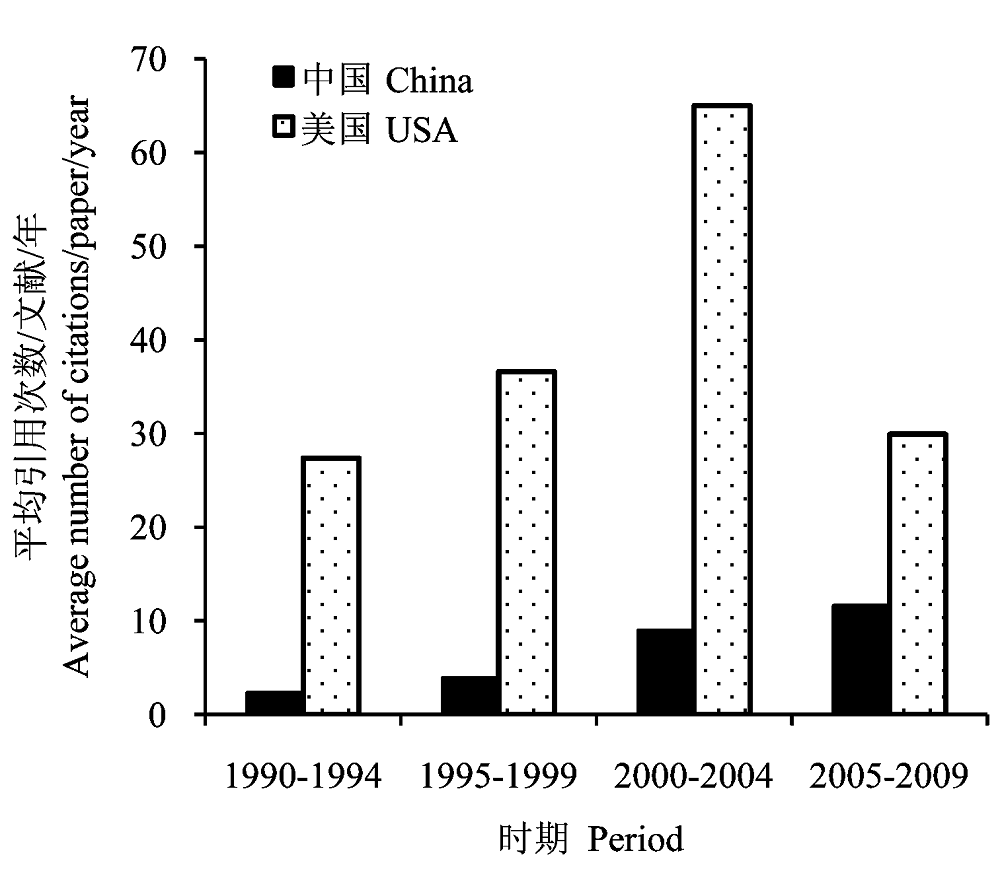
Fig. 4 USA and China average annual citations of the 10 most cited papers published during different periods from 1990-2009. For each calculation period, citation numbers were calculated with a two year delay. For examples, for paper published during 1990-1994, the citation counting period was 1992-1996 and for 2005-2009 papers, the citation counting period was 2007-2011.
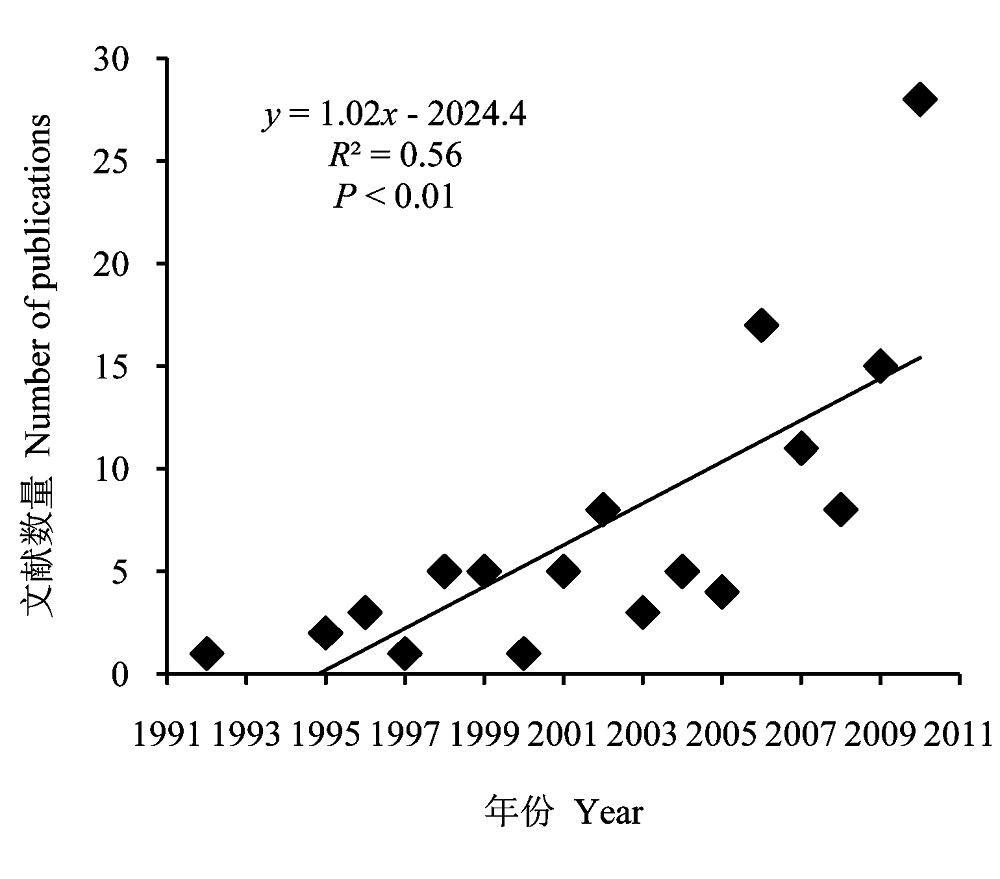
Fig. 5 The number of published articles by ornithologists of China in high impact journals related to ornithological research during 1991-2010. Journals included were such as Nature, Science, PLoS ONE, Oecologia, Molecular Ecology, BMC Evolutionary Biology, Journal of Molecular Biology, Molecular Phylogenetics and Evolution, Proceedings of the Royal Society B: Biological Sciences, Journal of Avian Biology, Behavioral Ecology, Animal Behaviour, Auk, Ibis, Condor, and Journal of Ornithology.
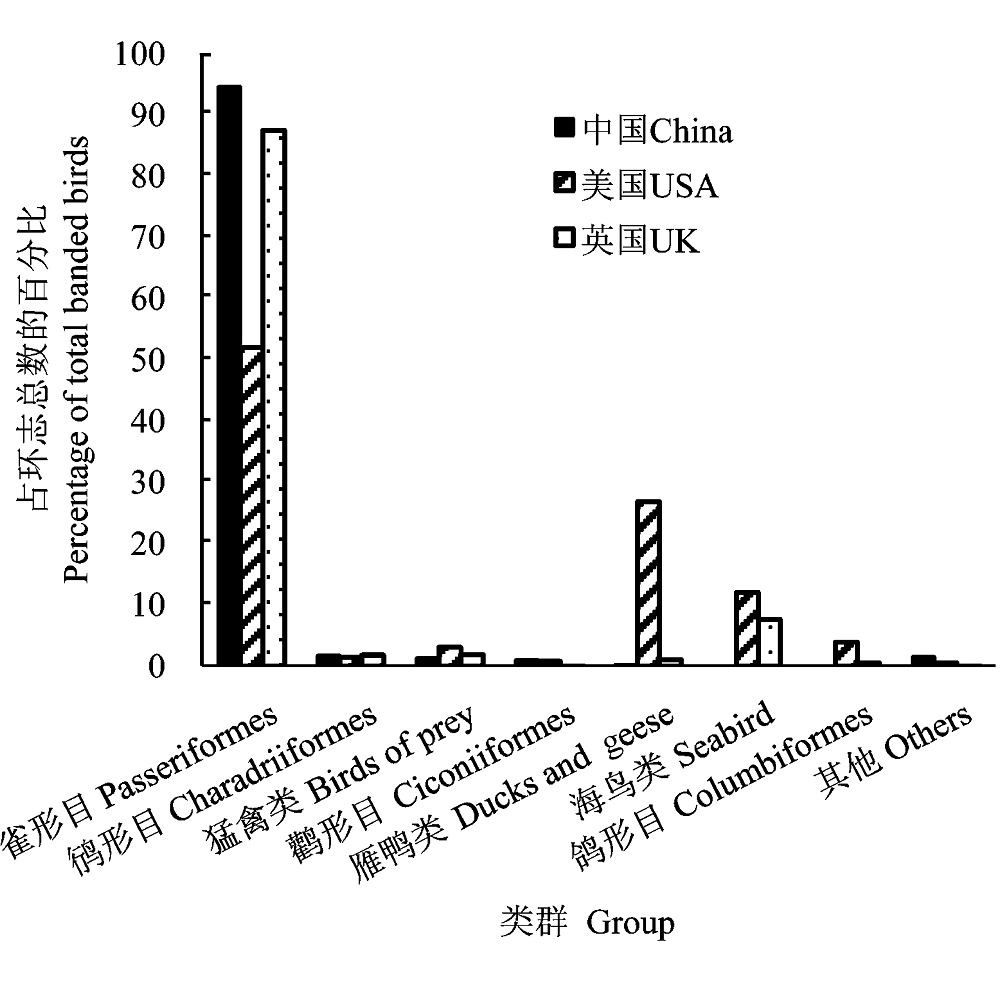
Fig. 6 Percentage distribution of banded birds by major taxonomical groups in China during 2010 (Hou & Jiang, 2011), in UK during 2009 (BTO, 2011) and in USA during 1960-2011 (USGS, 2011a).
| 潜在的研究领域 Potential areas | 具体探讨的问题 Questions |
|---|---|
| 迁徙各时期的关系 Migratory connectivity | 迁徙时期死亡发生在什么地点和时间? Where and when do animals die during migration? 在迁移过程中有多少个体死亡? How many animals die during migration? 迁徙动物种群的调控发生在何时、何地? Where and when are populations of migratory animals regulated? |
| 迁徙的行为和生态 Behavior and ecology of movement | 动物如何确定迁移的方向? How do animals orient during migration? 动物如何在迁徙时确定它们在地球上的位置? How do animals determine where they are on the globe during migration? 气候变化将如何影响迁徙动物? How will climate change affect migratory animals? 停留栖息地的质量如何影响鸟类继续迁徙的决定和成功率? How does stopover habitat quality affect birds’ migratory decisions and success? 鸟类对当地环境变化的响应如何影响它们在大尺度迁徙的模式? How do local responses to environment affect large-scale movement patterns? |
| 迁徙飞行中的行为和种群的空间动态 In-flight behavior and dynamic spatial demography | 当年幼鸟向出生地外扩散的距离有多远? How far do young migratory animals disperse from their natal territories? 迁徙时期死亡发生在什么地点和时间? Where and when do animals die during migration? 什么因素导致成鸟或幼鸟向新的繁殖地扩散? What factors prompt dispersal to a new breeding site in adults and juveniles? |
| 迁徙的生理生态 Physiological ecology of migration | 鸟类用什么样的生理策略减少迁移过程中的能量消耗? What physiological strategies do animals use to minimize energy costs during migration? 个体间和种群间的迁徙代价是有怎样的不同以及为什么? How and why do the costs of migration vary among individuals and species? 鸟类到达迁徙中途停歇地后是否开始增重? Do birds begin gaining weight immediately upon landing in stopover habitat? 在迁移过程中发生哪些生理上的权衡?这些权衡是如何产生的? What physiological trade-offs occur during migration, and how do these trade-offs come about? |
Table 4 Potential areas of future migration study (Robinson et al., 2010)
| 潜在的研究领域 Potential areas | 具体探讨的问题 Questions |
|---|---|
| 迁徙各时期的关系 Migratory connectivity | 迁徙时期死亡发生在什么地点和时间? Where and when do animals die during migration? 在迁移过程中有多少个体死亡? How many animals die during migration? 迁徙动物种群的调控发生在何时、何地? Where and when are populations of migratory animals regulated? |
| 迁徙的行为和生态 Behavior and ecology of movement | 动物如何确定迁移的方向? How do animals orient during migration? 动物如何在迁徙时确定它们在地球上的位置? How do animals determine where they are on the globe during migration? 气候变化将如何影响迁徙动物? How will climate change affect migratory animals? 停留栖息地的质量如何影响鸟类继续迁徙的决定和成功率? How does stopover habitat quality affect birds’ migratory decisions and success? 鸟类对当地环境变化的响应如何影响它们在大尺度迁徙的模式? How do local responses to environment affect large-scale movement patterns? |
| 迁徙飞行中的行为和种群的空间动态 In-flight behavior and dynamic spatial demography | 当年幼鸟向出生地外扩散的距离有多远? How far do young migratory animals disperse from their natal territories? 迁徙时期死亡发生在什么地点和时间? Where and when do animals die during migration? 什么因素导致成鸟或幼鸟向新的繁殖地扩散? What factors prompt dispersal to a new breeding site in adults and juveniles? |
| 迁徙的生理生态 Physiological ecology of migration | 鸟类用什么样的生理策略减少迁移过程中的能量消耗? What physiological strategies do animals use to minimize energy costs during migration? 个体间和种群间的迁徙代价是有怎样的不同以及为什么? How and why do the costs of migration vary among individuals and species? 鸟类到达迁徙中途停歇地后是否开始增重? Do birds begin gaining weight immediately upon landing in stopover habitat? 在迁移过程中发生哪些生理上的权衡?这些权衡是如何产生的? What physiological trade-offs occur during migration, and how do these trade-offs come about? |
| [1] |
Aldhous P, Tomlin S (2005) Avian flu: are we ready? Nature, 435, 399.
DOI URL PMID |
| [2] |
Alerstam T (1991) Bird flight and optimal migration. Trends in Ecology and Evolution, 6, 210-215.
URL PMID |
| [3] |
Alerstam T, Hedenstram A (1998) The development of bird migration theory. Journal of Avian Biology, 29, 343-369.
DOI URL |
| [4] |
Bao XK, Liu NF, Qu JY, Wang XL, An B, Wen LY, Song S (2010) The phylogenetic position and speciation dynamics of the genus Perdix (Phasianidae, Galliformes). Molecular Phylogenetics and Evolution, 56, 840-847.
URL PMID |
| [5] | Battley PF, Rogers DI, van Gils JA, Piersma T, Hassell CJ, Boyle A, Yang HY (2005) How do red knots Calidris canutus leave Northwest Australia in May and reach the breeding grounds in June? Predictions of stopover times, fuelling rates and prey quality in the Yellow Sea. Journal of Avian Biology, 36, 494-500. |
| [6] | Bennett MT (2008) China’s sloping land conversion program: institutional innovation or business as usual? Ecological Economics, 65, 699-711. |
| [7] |
Bensch S, Grahn M, Müller N, Gay L, Åkesson S (2009) Genetic, morphological, and feather isotope variation of migratory willow warblers show gradual divergence in a ring. Molecular Ecology, 18, 3087-3096.
DOI URL PMID |
| [8] |
Bensch S, Waldenström J, Jonzén N, Westerdahl H, Hansson B, Sejberg D, Hasselquist D (2007) Temporal dynamics and diversity of avian malaria parasites in a single host species. Journal of Animal Ecology, 76, 112-122.
DOI URL PMID |
| [9] | Berthold P, Gwinner E, Sonnenschein E (2003) Avian Migration. Springer, Berlin. |
| [10] | Berthold P, Helbig AJ, Mohr G, Querner U (1992) Rapid microevolution of migratory behaviour in a wild bird species. Nature, 360, 668-670. |
| [11] | Bibby CJ, Burgess ND, Hill DA, Mustoe SH (2000) Bird Census Techniques, 2nd edn. Academic Press, London. |
| [12] |
Blackburn TM, Cassey P, Duncan RP, Evans KL, Gaston KJ (2004) Avian extinction and mammalian introductions on oceanic islands. Science, 305, 1955-1958.
DOI URL PMID |
| [13] | Blair R (2004) The effects of urban sprawl on birds at multiple levels of biological organization. Ecology and Society, 9, 2. |
| [14] |
Both C, Visser ME (2001) Adjustment to climate change is constrained by arrival date in a long-distance migrant bird. Nature, 411, 296-298.
URL PMID |
| [15] | BTO (2011) Online ringing reports. http://www.bto.org/vol-unteer-surveys/ringing/publications/online-ringing-reports (accessed 2011-07-23). |
| [16] | Buckland ST, Anderson DR, Burnham KP, Laake JL, Borchers DL, Thomas L (2001) Introduction to Distance Sampling: Estimating Abundance of Biological Populations. Oxford University Press, Oxford. |
| [17] | Burkhardt RW Jr (2005) Patterns of Behavior: Konrad Lorenz, Niko Tinbergen, and the Founding of Ethology. University of Chicago Press, Chicago. |
| [18] | Burnham KP, Anderson DR (2010) Model Selection and Multi-Model Inference: A Practical Information-Theoretic Approach. Springer-Verlag, New York. |
| [19] |
Butler CJ (2003) The disproportionate effect of global warming on the arrival dates of short-distance migratory birds in North America. Ibis, 145, 484-495.
DOI URL |
| [20] |
Carpenter JP, Wang Y, Schweitzer CJ, Hamel PB (2011) Avian community and microhabitat associations of cerulean warblers in Alabama. The Wilson Journal of Ornithology, 123, 206-217.
DOI URL |
| [21] | Carver E (2009) Birding in the United States: A Demographic and Economic Analysis. Report 2006-4 U.S. Fish and Wildlife Service, Washington, DC. |
| [22] | Cheng TH (1987) A Synopsis of the Avifauna of China. Science Press, Beijing; Paul Parey Scientific Publishers, Berlin. |
| [23] | Cheng TH (1989) An overview of research on pheasants of China. In: Proceeding of the 4th Symposium of Pheasants, pp. 1-10. World Pheasant Association. |
| [24] | Cheng TH (郑作新) (1994) A Complete Checklist of Species and Subspecies of the Chinese Bird Species (中国鸟类种和亚种分类名录大全). Science Press, Beijing. (in Chinese) |
| [25] |
Clobert JJ, Le Galliard F, Cote J, Meylan S, Massot M (2009) Informed dispersal, heterogeneity in animal dispersal syndromes and the dynamics of spatially structured populations. Ecology Letters, 12, 197-209.
URL PMID |
| [26] |
Crick HQP, Sparks TH (1999) Climate change related to egg-laying trends. Nature, 399, 423-424.
DOI URL |
| [27] | Desmond A, Moore J (1991) Darwin. Michael Joseph, Penguin Group, London. |
| [28] |
Ding CQ (2010) Crested ibis. Chinese Birds, 1, 156-162.
DOI URL |
| [29] |
Du B, Lu X (2009) Bi-parental vs. cooperative breeding in a passerine: fitness-maximizing strategies of males in response to risk of extra-pair paternity? Molecular Ecology, 18, 3929-3939.
URL PMID |
| [30] |
Du B, Lu X (2010) Sex allocation and paternity in a cooperatively breeding passerine: evidence for the male attractiveness hypothesis? Behavioral Ecology and Sociobiology, 64, 1631-1639.
DOI URL |
| [31] | Dunn PO, Winker DW (1999) Climate change has affected the breeding date of tree swallows throughout North America. Proceedings of the Royal Society B: Biology, 266, 2487-2490. |
| [32] | Editorial Board of Chinese Birds (2010) Editorial. Chinese Birds, 1. |
| [33] |
Faaborg J, Holmes RT, Anders AD, Bildstein KL, Dugger KM, Gauthreaux SA Jr, Heglund P, Hobson KA, Jahn AE, Johnson DH, Latta SC, Levey DJ, Marra PP, Merkord CL, Nol E, Rothstein SI, Sherry TW, Sillett TS, Thompson FR III, Warnock N (2010) Recent advances in understanding migration systems of New World land birds. Ecological Monographs, 80, 3-48.
DOI URL |
| [34] |
Gaston KJ (2000) Global patterns in biodiversity. Nature, 405, 220-227.
URL PMID |
| [35] |
Ghalambor CK, Martin TE (2001) Fecundity-survival trade- offs and parental risk-taking in birds. Science, 292, 494-497.
DOI URL PMID |
| [36] |
Gill RE, Tibbitts TL, Douglas DC, Handel CM, Mulcahy DM, Gottschalck JC, Warnock N, McCaffery BJ, Battley PF, Piersma T (2009) Extreme endurance flights by landbirds crossing the Pacific Ocean: ecological corridor rather than barrier? Proceedings of the Royal Society B: Biological Sciences, 276, 447-458.
DOI URL PMID |
| [37] | Grinnell J (1936) Trends in modern ornithology. The Wilson Bulletin, 48, 73-77. |
| [38] | Hackett SJ, Kimball RT, Reddy S, Bowie RCK, Braun EL, Braun MJ, Chojnowski JL, Cox WA, Han KL, Harman J, Huddleston CJ, Marks BD, Miglia KJ, Moore WS, Sheldon FH, Steadman DW, Witt CC, Yuri T (2008) A phylogenomic study of birds reveals their evolutionary history. Science, 27, 1763-1768. |
| [39] |
Haig SM, Bronaugh WM, Crowhurst RS, D’Elia J, Eagles-Smith CA, Epps CW, Knaus B, Miller MP, Moses ML, Oyler-McCance S, Robinson WD, Sidlauskas B (2011) Genetic applications in avian conservation. Auk, 128, 205-229.
DOI URL |
| [40] | Hamel PB (2000) Cerulean Warbler Status Assessment. U. S. Fish & Wildlife Service, Minneapolis, Minnesota. |
| [41] |
Hamel PB, Dawson DK, Keyser PD (2004) How we can learn more about the cerulean warbler (Dendroica cerulea)? Auk, 121, 7-14.
DOI URL |
| [42] |
Hamilton WD (1964a) The genetical evolution of social behaviour. I. Journal of Theoretical Biology, 7, 1-16.
DOI URL PMID |
| [43] |
Hamilton WD (1964b) The genetical evolution of social behaviour. II. Journal of Theoretical Biology, 7, 17-52.
URL PMID |
| [44] | Hanski I (1999) Metapopulation Ecology. Oxford University Press, London. |
| [45] |
Hatchwell BJ (1999) Investment strategies of breeders in avian cooperative breeding systems. The American Naturalist, 154, 205-219.
URL PMID |
| [46] | Hatchwell BJ (2007) Avian reproduction: role of ecology in the evolution of cooperative breeding. Current Biology, 17, 845-847. |
| [47] |
Hebert PDN, Cywinska A, Ball SL, deWaard JR (2003) Biological identifications through DNA barcodes. Proceedings of the Royal Society of London Series B: Biological Sciences, 270, 313-321.
URL PMID |
| [48] | Hebert PDN, Stoeckle MY, Zemlak TS, Francis CM (2004) Identification of birds through DNA barcodes. PLoS Biology, 2, 1657-1663. |
| [49] |
Hitch AT, Leberg PL (2007) Breeding distributions of North American bird species moving north as a result of climate change. Conservation Biology, 21, 534-539.
DOI URL PMID |
| [50] |
Hobson KA (1999) Tracing origins and migration of wildlife using stable isotopes: a review. Oecologia, 120, 314-326.
DOI URL PMID |
| [51] | Hobson KA (2005) Flying fingerprints: making connections with stable isotopes and trace element. In: Birds of Two Worlds: the Ecology and Evolution of Migration (eds Greenberg R, Marra PP), pp. 235-246. Smithsonian Institution, Washington, DC. |
| [52] |
Holmes D, Martin K (2009) A bird’s-eye view of aging: what’s in it for ornithologists? Auk, 126, 1-23.
DOI URL |
| [53] |
Hou LH, Martin LD, Zhou ZH, Feduccia A (1996) Early adaptive radiation of birds: evidence from fossils from northeastern China. Science, 274, 1164-1167.
DOI URL PMID |
| [54] | Hou YQ (侯韵秋), Jiang HX (江红星) (2011) 449 species 254,400 birds banded in 2010. Newsletter of China Ornithological Society (中国鸟类学会通讯), 20(1), 34. (in Chinese with English abstract) |
| [55] | Hougner C, Colding J, Söderqvist T (2006) Economic valuation of a seed dispersal service in the Stockholm National Urban Park, Sweden. Ecological Economics, 59, 364-374. |
| [56] |
Irwin DE, Bensch S, Irwin JH, Price TD (2005) Speciation by distance in a ring species. Science, 307, 414-416.
DOI URL PMID |
| [57] | Ji Q, Currie PJ, Norell MA, Ji SA (1998) Two feathered dinosaurs from northeastern China. Nature, 393, 753-761. |
| [58] | Jia CX, Sun YH, Swenson JE (2010) Unusual incubation behavior and embryonic tolerance of hypothermia by the blood pheasant (Ithaginis cruentus). Auk, 127, 926-931. |
| [59] |
Koh CN, Lee PF, Lin RS (2006) Bird species richness patterns of northern Taiwan: primary productivity, human population density, and habitat heterogeneity. Diversity and Distributions, 12, 546-554.
DOI URL |
| [60] |
Korte SM, Koolhaas JM, Wingfield JC, McEwen BS (2005) The Darwinian concept of stress: benefits of allostasis and costs of allostatic load and the trade-offs in health and disease. Neuroscience and Biobehavioral Reviews, 29, 3-38.
DOI URL PMID |
| [61] |
Kou Z, Li YD, Yin ZH, Guo S, Wang ML, Gao XB, Li P, Tang LJ, Jiang P, Xin Z, Ding CQ, He YB, Ren ZY, Cui P, Zhao HF, Zhang Z, Tang S, Yan BP, Lei FM, Li TX (2009) The survey of H5N1 Flu Virus in wild birds in 14 provinces of China from 2004 to 2007. PLoS ONE, 4, e6926.
DOI URL PMID |
| [62] |
Lack D (1947) The significance of clutch-size. Ibis, 89, 302-352.
DOI URL |
| [63] | Lack D (1948) The significance of clutch-size. part III. Some interspecific comparisons. Ibis, 90, 25-45. |
| [64] | LaRouche GP (2003) Birding in the United States: A Demographic and Economic Analysis. Report 2001-1.U.S. Fish and Wildlife Service, Washington, DC. |
| [65] |
LaSorte FA, Thompson FR III (2007) Poleward shifts in winter ranges of North American birds. Ecology, 88, 1803-1812.
DOI URL PMID |
| [66] | Lei FM, Qu YH, Lu JL, Liu Y, Yin ZH (2003) Conservation on diversity and distribution patterns of endemic birds in China. Biodiversity and Conservation, 12, 239-254. |
| [67] | Lennon JJ, Koleff P, Greenwood JJD, Gaston KJ (2001) The geographical structure of British bird distributions: diversity, spatial turnover and scale. Journal of Animal Ecology, 70, 966-979. |
| [68] |
Li JQ, Lin ST, Wang Y, Zhang ZW (2009a) Nest-dismantling behavior of the hair-crested drongo in central China: an adaptive behavior for increasing fitness. Condor, 111, 197-201.
DOI URL |
| [69] |
Li SH, Yeung CKL, Feinstein J, Han LX, Manh HL, Wang CX, Ding P (2009b) Sailing through the late Pleistocene: unusual historical demography of an East Asian endemic, the Chinese Hwamei (Leucodioptron canorum canorum), during the last glacial period. Molecular Ecology, 18, 622-633.
URL PMID |
| [70] |
Liu JH, Xiao HX, Lei F, Zhu Q, Zhang XW, Zhang XL, Zhao D, Wang G, Feng Y, Ma J, Liu W, Wang J, Gao GF (2005) Highly pathogenic H5N1 influenza virus infection in migratory birds. Science, 309, 1206.
DOI URL PMID |
| [71] | Lu X, Zheng GM (2003) Reproductive ecology of Tibetan eared pheasant Crossoptilon harmani in scrub environment, with special reference to the effect of food. Ibis, 145, 657-666. |
| [72] | Ma ZJ (马志军), Li B (李博), Chen JK (陈家宽) (2005a) Study on the utilization of stopover sites and migration strategies of migratory birds. Acta Ecologica Sinica (生态学报), 25, 1404-1412. (in Chinese with English abstract) |
| [73] |
Ma ZJ, Li B, Zhao B, Jing K, Tang SM, Chen JK (2004) Are artificial wetlands good alternatives to natural wetlands for waterbirds? A case study on Chongming Island, China. Biodiversity and Conservation, 13, 333-350.
DOI URL |
| [74] | Ma ZJ (马志军), Wang Y (王勇), Chen JK (陈家宽) (2005b) Physiological ecology of migratory birds during the stopover periods. Acta Ecologica Sinica (生态学报), 25, 3067-3075. (in Chinese with English abstract) |
| [75] | MacArthur RH (1965) Patterns of species diversity. Biological Review, 40, 510-533. |
| [76] | MacArthur RH, Wilson EO (1967) The Theory of Island Biogeography. Princeton University Press, Princeton. |
| [77] | MacKenzie DI, Nichols JD, Royle JA, Pollock KH, Bailey LL, Hines JE (2006) Occupancy Estimation and Modeling: Inferring Patterns and Dynamics of Species Occurrence. Elsevier, Massachusetts. |
| [78] | MacMynowski DP, Root TL, Ballard G, Geupel GR (2007) Changes in spring arrival of Nearctic-Neotropical migrants attributed to multiscalar climate. Global Change Biology, 13, 2239-2251. |
| [79] | Magrath RD, Leedman AW, Gardner JL, Giannasca A, Nathan AC, Yezerinac SM, Nicholls JA (2000) Life in the slow lane: reproductive life history of the white-browed scrubwren, an Australian endemic. Auk, 117, 479-489. |
| [80] | Marra PP, Dove CJ, Dolbeer R, Dahlan NF, Heacker M, Whatton JF, Diggs NE, France C, Henkes GA (2009) Migratory Canada geese cause crash of US Airways Flight 1549. Frontier in Ecology and Environment, 7, 297-301. |
| [81] | Martin TE (1987) Food as a limit on breeding birds: a life-history perspective. Annual Review of Ecology and Systematics, 18, 453-487. |
| [82] | Martin TE (1996) Life history evolution in tropical and south temperate birds: what do we really know? Journal of Avian Biology, 27, 263-272. |
| [83] | Martin TE (1998) Are microhabitat preferences of coexisting species under selection and adaptive? Ecology, 79, 656-670. |
| [84] |
Martin TE, Auer SK, Bassar RD, Niklison AM, Lloyd P (2007) Geographic variation in avian incubation periods and parental influences on embryonic temperature. Evolution, 61, 2558-2569.
DOI URL PMID |
| [85] | Martin TE, Finch DM (1995) Ecology and Management of Neotropical Migratory Birds. Oxford University Press, New York. |
| [86] | McGowan PJK, Zhang YY, Zhang ZW (2009) Galliformes- barometers of the state of applied ecology and wildlife conservation in China. Journal of Applied Ecology, 46, 524-526. |
| [87] |
Merino S, Moreno J, Sanz JJ, Arriero E (2000) Are avian blood parasites pathogenic in the wild? A medication experiment in blue tits (Parus caeruleus). Proceedings of the Royal Society B:Biological Sciences, 267, 2507-2510.
DOI URL |
| [88] | Millennium Ecosystem Assessment (2005) Ecosystems and Human Well-being: Desertification Synthesis. World Resources Institute, Washington, DC. |
| [89] |
Mittelbach GG, Schemske DW, Cornell HV, Allen AP, Brown JM, Bush MB, Harrison SP, Hurlbert AH, Knowlton N, Lessios HA, McCain CM, McCune AR, McDade LA, McPeek MA, Near TJ, Price TD, Ricklefs RE, Roy K, Sax DF, Schluter D, Sobel JM, Turelli M (2007) Evolution and the latitudinal diversity gradient: speciation, extinction and biogeography. Ecology Letters, 10, 315-331.
DOI URL |
| [90] |
Møller AP (1992) Female swallow preference for symmetrical male sexual ornaments. Nature, 357, 238-240.
DOI URL PMID |
| [91] |
Møller AP (1997) Developmental stability and fitness: a review. The American Naturalist, 149, 916-932.
DOI URL PMID |
| [92] | Møller AP, Alatalo RV (1999) Good-genes effects in sexual selection. Proceedings of the Royal Society B: Biological Sciences, 266, 85-91. |
| [93] | Møller AP, Pomiankowski A (1993) Why have birds got multiple sexual ornaments. Behavioral Ecology and Sociobiology, 32, 167-176. |
| [94] | Moreno J, Osorno JL (2003) Avian egg colour and sexual selection: does eggshell pigmentation reflect female condition and genetic quality? Ecology Letter, 6, 803-806. |
| [95] | Morrison ML, Block MW, Strickland MD, Collier BA, Peterson MJ (2008) Wildlife Study Design, 2nd edn. SpringerScience, New York. |
| [96] | Murphy-Klassen HM, Underwood TJ, Sealy SG, Czyrnyj AA (2005) Long-term trends in spring arrival dates of migrant birds at Delta Marsh, Manitoba, in relation to climate change. Auk, 122, 1130-1148. |
| [97] | Newton I (2008) The Migration Ecology of Birds. Academic Press, London. |
| [98] | Peh KSH (2007) Potential effects of climate change on elevational distributions of tropical birds in Southeast Asia. Condor, 109, 437-441. |
| [99] | Piersma T, Jukema J (1990) Budgeting the flight of a long-distance migrant: changes in nutrient reserve levels of bar-tailed godwits at successive spring staging sites. Ardea, 78, 315-337. |
| [100] |
Piersma T, Lindström Å (1997) Rapid reversible changes in organ size as a component of adaptive behaviour. Trends in Ecology and Evolution, 12, 134-138.
DOI URL PMID |
| [101] |
Pounds JA, Fogden MPL, Campbell JH (1999) Biological response to climate change on a tropical mountain. Nature, 398, 611-615.
DOI URL |
| [102] |
Qian FW, Wu HQ, Gao LB, Zhang HG, Li FS, Zhong XY, Yang XJ, Zheng GM (2009) Migration routes and stopover sites of black-necked cranes determined by satellite tracking. Journal of Field Ornithology, 80, 19-26.
DOI URL |
| [103] |
Qu YH, Ericson PGP, Lei FM, Li SH (2005) Postglacial colonization of the Tibetan Plateau inferred from the matrilineal genetic structure of the endemic red-necked snow finch, Pyrgilauda ruficollis. Molecular Ecology, 14, 1767-1781.
DOI URL PMID |
| [104] | Reznick D (1985) Costs of reproduction: an evaluation of the empirical evidence. Oikos, 44, 256-267. |
| [105] | Ricklefs RE (1991) Structures and transformations of life histories. Functional Ecology, 5, 174-183. |
| [106] | Ricklefs RE, Fallon SM, Latta SC, Swanson BL, Bermingham E (2005) Migrants and their parasites: a bridge between two worlds. In: Birds of Two Worlds: the Ecology and Evolution of Migration (eds Greenberg R, Marra PP), pp. 210-221. Smithsonian Institution, Washington, D.C. |
| [107] | Ricklefs RE, Wikelski M (2002) The physiology life history nexus. Trends in Ecology and Evolution, 17, 462-468. |
| [108] | Robinson WD, Bowlin MS, Bisson I, Shamoun-Baranes J, Thorup K, Diehl RH, Kunz TH, Mabey S, Winkler DW (2010) Integrating concepts and technologies to advance the study of bird migration. Frontiers in Ecology and the Environment, 8, 354-361. |
| [109] | Seavy NE, Dybala KE, Snyder MA (2008) Climate models and ornithology. Auk, 125, 1-10. |
| [110] |
Sereno PC, Rao CG (1992) Early evolution of avian flight and perching: new evidence from the lower Cretaceous of China. Science, 255, 845-848.
DOI URL PMID |
| [111] | Sherry TW, Holmes RT (1995) Summer versus winter limitation of populations: conceptual issues and evidence? In: Ecology and Management of Neotropical Migratory Birds (eds Martin TE, Finch DM), pp. 85-120. Oxford University Press, New York. |
| [112] |
Sibley CG, Ahlquist JE, Monroe BL Jr (1988) A classification of the living birds of the world based on DNA-DNA hybridization studies. Auk, 105, 409-423.
DOI URL |
| [113] | Smith TB, Clegg SM, Kimura M, Ruegg KC, Milá B, Lovette IJ (2005) Molecular genetic approaches to linking breeding and overwintering areas in five neotropical migrant passerines. In: Birds of Two Worlds: the Ecology and Evolution of Migration (eds Greenberg R, Marra PP), pp. 222-234. Smithsonian Institution, Washington, DC. |
| [114] | Stearns SC (1989) Trade-offs in life-history evolution. Functional Ecology, 3, 259-268. |
| [115] | Thomson Reuters (2011) Journal Citation Report. http://thom-sonreuters.com/products_services/science/science_products/a-z/journal_citation_reports/ (accessed 2011-07-23). |
| [116] |
Tryjanowski P, Sparks TH (2001) Is the detection of the first arrival date of migrating birds influenced by population size? A case study of the red-backed shrike Laniuscollurio. International Journal of Biometeorology, 45, 217-219.
DOI URL PMID |
| [117] | USGS (2011a) How many birds are banded? http://www.pwrc.usgs.gov/BBL/homepage/howmany.cfm (accessed 2011-07-23). |
| [118] | USGS (2011b) North American breeding bird survey home. http://137.227.245.162/bbs/ (accessed 2011-09-12). |
| [119] |
Wang C, Lu X (2011) Female ground tits prefer relatives as extra-pair partners: driven by kin selection? Molecular Ecology, 20, 2851-2863.
DOI URL PMID |
| [120] |
Wang N, Zhang ZW (2009) The novel primers for sex identification in the brown eared-pheasant and their application to other species. Molecular Ecology Resources, 9, 186-188.
DOI URL PMID |
| [121] | Wang Y, Chang JC, Moore FR, Su LY, Cui LM, Yang XF (2006) Stopover ecology of red-flanked bush robin (Tarsiger cyanurus) at Maoershan, Northeast China. Acta Ecologica Sinica, 26, 638-646. |
| [122] |
Wang Y, Finch DM, Moore FR, Kelly J (1998) Stopover ecology and habitat use of migratory Wilson’s warbler. Auk, 115, 829-842.
DOI URL |
| [123] |
Wang Y, Moore FR (1997) Spring stopover of intercontinental migratory thrushes along the northern coast of the Gulf of Mexico. Auk, 114, 263-278.
DOI URL |
| [124] |
Wingfield JC, Hegner RE, Dufty AM Jr, Ball GF (1990) The “challenge hypothesis”: theoretical implications for patterns of testosterone secretion, mating systems, and breeding strategies. American Naturalist, 136, 829-846.
DOI URL |
| [125] |
Wingfield JC, Maney DL, Breuner CW, Jacobs JD, Lynn S, Ramenofsky M, Richardson RD (1998) Ecological bases of hormone-behavior interactions: the “emergency life history stage”. American Zoologist, 38, 191-206.
DOI URL |
| [126] | Wingfield JC, Sapolsky RM (2003) Reproduction and resistance to stress: when and how. Journal of Neuroendocrinology, 8, 711-724. |
| [127] |
Wingfield JC, Vleck CM, Moore MC (1992) Seasonal-changes of the adrenocortical response to stress in birds of the Sonoran Desert. Journal of Experimental Zoology, 264, 419-428.
DOI URL PMID |
| [128] | World Health Organization (WHO) (2004) Avian influenza (“bird flu”) and the significance of its transmission to humans. http://www.who.int/mediacentre/factsheets/avian_in-fluenza/en/print.html (accessed 2011-07-23). |
| [129] |
Wu HQ, Zha K, Zhang M, Yang XJ (2009) Nest site selection by black-necked crane Grus nigricollis in the Ruoergai Wetland, China. Bird Conservation International, 19, 277-286.
DOI URL |
| [130] |
Xia CW, Xiao H, Zhang YY (2010) Individual variation in brownish-flanked bush warbler songs. Condor, 112, 591-595.
DOI URL |
| [131] | Xu JL, Zhang XH, Sun QH, Zheng GM, Wang Y, Zhang ZW (2009) Home range, daily movements and site fidelity of male Reeves’s pheasants Syrmaticus reevesii in the Dabie Mountains, central China. Wildlife Biology, 15, 338-344. |
| [132] |
Xu X, Ma QY, Hu DY (2010) Pre-Archaeopteryx coelurosaurian dinosaurs and their implications for understanding avian origins. Chinese Science Bulletin, 55, 3971-3977.
DOI URL |
| [133] |
Xu X, Zhou ZH, Wang XL, Kuang XW, Zhang FC, Du XK (2003) Four-winged dinosaurs from China. Nature, 421, 335-340.
URL PMID |
| [134] |
Yang C, Liang W, Cai Y, Shi S, Takasu F, Møller AP, Antonov A, Fossøy F, Moksnes A, Røskaft E, Stokke B (2010) Coevolution in action: disruptive selection on egg colour in an avian brood parasite and its host. PLoS ONE, 5, e10816.
DOI URL PMID |
| [135] | Young L, Zheng GM, Zhang ZW (1991) Winter movements and habitat use by Cabot’s tragopans Tragopan caboti in Southeastern China. Ibis, 133, 121-126. |
| [136] |
Zhang P, Shao G, Zhao G, Master DCL, Parker GR, Dunning JB, Li Q (2000) China’s forest policy for the 21st century. Science, 288, 2135-2136.
DOI URL PMID |
| [137] | Zhang YY, Zheng GM (2007) A population viability analysis (PVA) for Cabot’s tragopan (Tragopan caboti) in Wuyanling, south-east China. Bird Conservation International, 17, 151-161. |
| [138] | Zhao ZJ (赵正阶) (2001) A Handbook of the Birds of China (中国鸟类志). Jilin Science and Technology Press, Changchun. (in Chinese) |
| [139] | Zheng GM (郑光美) (2002) A Cheklist on the Classification and Distribution of the Birds of the World (世界鸟类分类与分布名录). Science Press, Beijing. (in Chinese) |
| [140] | Zheng GM (郑光美) (2011) A Checklist on the Classification and Distribution of the Birds of China, 2nd edn. (中国鸟类分类与分布名录, 第二版). Science Press, Beijing. (in Chinese) |
| [141] | Zhou B, Zhou LZ, Chen JY, Cheng YQ, Xu WB (2010) Diurnal time-activity budgets of wintering hooded cranes (Grus monacha) in Shengjin Lake, China. Waterbirds, 33, 110-115. |
| [142] |
Zou FS, Lim HC, Marks BD, Moyle RG, Sheldon FH (2007) Molecular phylogenetic analysis of the grey-cheeked fulvetta (Alcippe morrisonia) of China and Indochina: a case of remarkable genetic divergence in a “species”. Molecular Phylogenetics and Evolution, 44, 165-174.
URL PMID |
| [143] |
Zhou ZH, Barrett PM, Hilton J (2003) An exceptionally preserved Lower Cretaceous ecosystem. Nature, 421, 807-814.
DOI URL PMID |
| [1] | Zhou Zhihua, Jin Xiaohua, Luo Ying, Li Diqiang, Yue Jianbing, Liu Fang, He Tuo, Li Xi, Dong Hui, Luo Peng. Analyses and suggestions on mechanisms of forestry and grassland administrations in China to achieve targets of Kunming-Montreal Global Biodiversity Framework [J]. Biodiv Sci, 2025, 33(3): 24487-. |
| [2] | Tian Zhiqi, Su Yang. China’s implementation model of international environmental conventions and its application to the Convention on Biological Diversity—Achieving the Kunming-Montreal Global Biodiversity Framework targets and the role of national parks [J]. Biodiv Sci, 2025, 33(3): 24593-. |
| [3] | Wei Yi, Yi Ai, Meng Wu, Liming Tian, Tserang Donko Mipam. Soil archaeal community responses to different grazing intensities in the alpine meadows of the Qinghai-Tibetan Plateau [J]. Biodiv Sci, 2025, 33(1): 24339-. |
| [4] | Bangze Li, Shuren Zhang. An updated species checklist and taxonomic synopsis of Cyperaceae in China [J]. Biodiv Sci, 2024, 32(7): 24106-. |
| [5] | Zonggang Hu. China and the United States once planned joint compilation of the Flora of China after the victory in the China’s Resistance War Against Japan [J]. Biodiv Sci, 2024, 32(6): 24220-. |
| [6] | Qiyu Kuang, Liang Hu. Species diversity and geographical distribution of marine benthic shell-bearing mollusks around Donghai Island and Naozhou Island, Guangdong Province [J]. Biodiv Sci, 2024, 32(5): 24065-. |
| [7] | Yujie Chi, Xintian Zhang, Zhixuan Tian, Chengshuai Guan, Xinzhi Gu, Zhihui Liu, Zhanbin Wang, Jinjie Wang. Species diversity of powdery mildew fungi (Erysiphaceae) and their host plants in Northeast Asia [J]. Biodiv Sci, 2024, 32(4): 23443-. |
| [8] | Di Lin, Shuanglin Chen, Que Du, Wenlong Song, Gu Rao, Shuzhen Yan. Investigation of species diversity of myxomycetes in Dabie Mountains [J]. Biodiv Sci, 2024, 32(2): 23242-. |
| [9] | Jianping Jiang, Bo Cai, Bin Wang, Weitao Chen, Zhixin Wen, Dezhi Zhang, Lulu Sui, Shun Ma, Weibo Wang. New vertebrate species discovered in China in 2023 [J]. Biodiv Sci, 2024, 32(11): 24327-. |
| [10] | Huanxi Cao, Qingsong Zhou, Arong Luo, Pu Tang, Tingjing Li, Zejian Li, Huayan Chen, Zeqing Niu, Chaodong Zhu. New taxa of extant Hymenoptera in 2023 [J]. Biodiv Sci, 2024, 32(11): 24319-. |
| [11] | Cheng Du, Jun Liu, Wen Ye, Shuai Liao. 2023 annual report on new taxa and nomenclatural changes for Chinese plants [J]. Biodiv Sci, 2024, 32(11): 24253-. |
| [12] | Siyuan Xu, Qiqi Lian, Ruixin Zhang, Jiateng Zhao, Xuan Zhou, Lu Zhou, Qin Chen, Ming Bai. The world new taxa of extant Coleoptera in 2023 [J]. Biodiv Sci, 2024, 32(11): 24307-. |
| [13] | Nuriye Muhetaier, Xiuying Zhang, Subinuer Eli, Houhun Li. Annual report of new taxa for Chinese Lepidoptera in 2023 [J]. Biodiv Sci, 2024, 32(11): 24428-. |
| [14] | Chen Lin, Qicheng Yang, Yanling Wu, Peng Hou, Bing Zhang, Ding Yang. New taxa of Diptera from China in 2023 [J]. Biodiv Sci, 2024, 32(11): 24328-. |
| [15] | Yuchen Du, Beimeng Liu, Junfeng Chen, Hao Wang, Yi Xie. Analysis of factors influencing farmers’ protection willingness based on structural equation model: Taking the Hunchun area of Northeast China Tiger and Leopard National Park as an example [J]. Biodiv Sci, 2024, 32(1): 23155-. |
| Viewed | ||||||
|
Full text |
|
|||||
|
Abstract |
|
|||||
Copyright © 2022 Biodiversity Science
Editorial Office of Biodiversity Science, 20 Nanxincun, Xiangshan, Beijing 100093, China
Tel: 010-62836137, 62836665 E-mail: biodiversity@ibcas.ac.cn ![]()